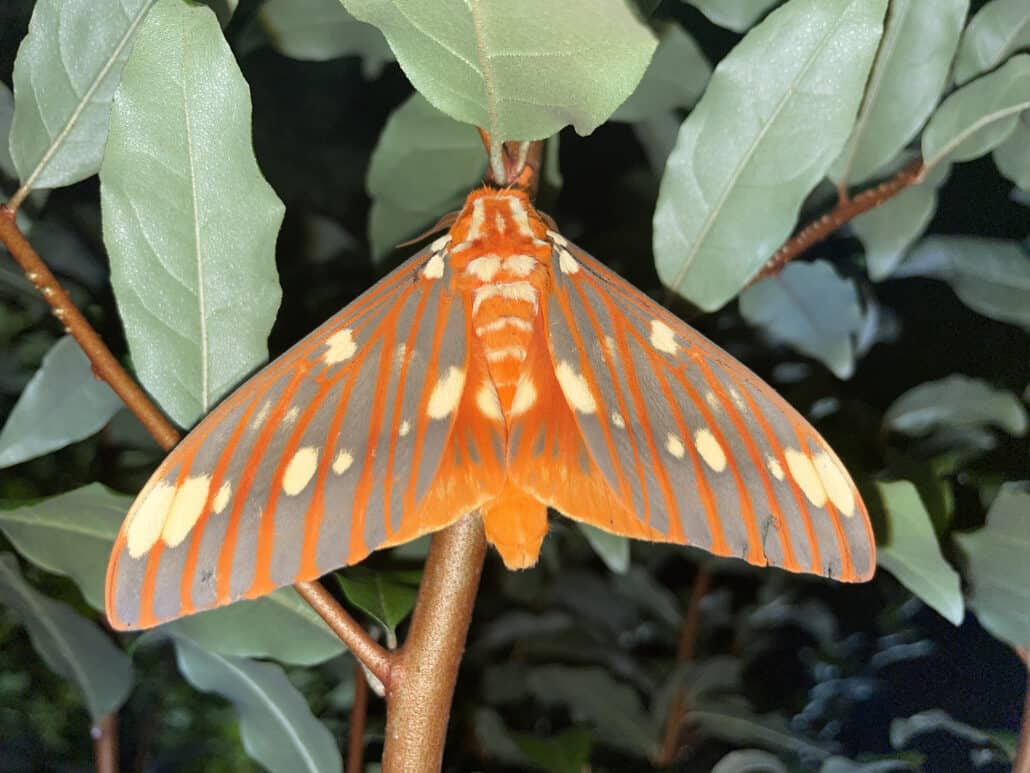
One thing about bird watchers is that we rarely stop with birds. Once you notice one winged creature, it’s difficult not to become interested in other winged things. Butterflies are a natural extension for birders, especially since the birds are a bit quieter and often hidden in leafed-out trees during the summer months. Meanwhile, butterflies are active and gorgeous and quietly commanding our attention and appreciation as they flit around our yards.
But moths? I often get a strange look when I tell people that I enjoy “mothing.” (And “herping,” but that’s another story!) For most folks, I am guessing the word moth produces a mental image of something brown and drab and bouncing off a porch light or stuck to a screen door. And while that is accurate for some moths, lumping all moths into that category is like writing off all birds as house sparrows.
Until a few years ago, I was one of those folks who did not give much thought to moths. But if there is such a thing as a “spark moth”—and surely there is—I remember noticing this perfectly camouflaged moth on my door frame. And then I noticed a differently patterned one on my screen. And a completely white one barely noticeable on the side of my white house… and… and…

With new eyes, I started seeing moths everywhere. And because I am a word person, I like to know the names of things, and that’s when I fell down the rabbit—er, moth—hole trying to identify what I was seeing, and in the process learning there is a great big mothing world out there I didn’t even know existed.
One of the resources I stumbled upon in my identification quest was Butterfly Ridge, a conservation center located about an hour away in the Hocking Hills region of southeastern Ohio. When I saw that they hold mothing events on Saturday nights during the summer, I knew I had to attend one and see what it was all about. (You can read about that adventure that I shared with two of my children here.)
Over the next couple of summers, I attended a few different mothing events, learning—and, the hard part, retaining—a little more each time. I would always share my photos with friends after, and the reaction was the same every time: “These are MOTHS??”

Who knew that after the sun went down and the mothing sheets and fluorescent lights went up, a rainbow of moths emerged from the darkness? I certainly didn’t until I fell into the mothing world, and now it’s something I look forward to every summer.
In fact, this year, I took my interest a step further to attend an event I had heard about but was a little intimidated by: MOTHAPALOOZA. Pre-pandemic, this annual event drew a couple hundred folks to the southwest corner of the state and is a well-known affair in the Ohio naturalist scene, with renowned guides and keynote speakers. This year, dubbed “Mothapalooza Light,” the event moved to a new location closer to me, and on a smaller scale of about 50 folks. I decided this was the year I would take the plunge and attend.

And I’m so glad I did! I need not have been intimidated. Just like serious birders, serious moth-ers are very welcoming and eager to share their knowledge with us more novice folks. And the moths in this remote spot, a 3,100-acre preserve called the Highland Nature Sanctuary, located in the Arc of Appalachia, put on quite a show. You have to be a bit of a night owl to have the full mothing experience, with activity peaking after midnight, but it is completely worth losing some sleep for. (And Mothapalooza organizers kindly offer an 11:00 breakfast time to compensate. This is unheard of in the birding world, with that whole “early bird gets the worm” thing!)
We saw moths of all shapes, sizes, and colors—not to mention all kinds of other winged critters like katydids, beetles, and a most handsome dobsonfly I developed an affection for. Even the most seasoned moth-ers among us got super excited about unexpected or rarely seen visitors. One never knows what just might show up on the mothing sheet!

I don’t think I will ever take to mothing with the same focus and passion I hold for birds. I don’t keep moth life lists (yet), and I have to relearn the same moth names every summer. But I have an insatiable appetite for being outdoors and learning about the creatures we inhabit this planet with, and mothing is a wonderful way to connect with others who share a keen curiosity, appreciation, and joy for the natural world.
Check out more moth photos by Jessica!















